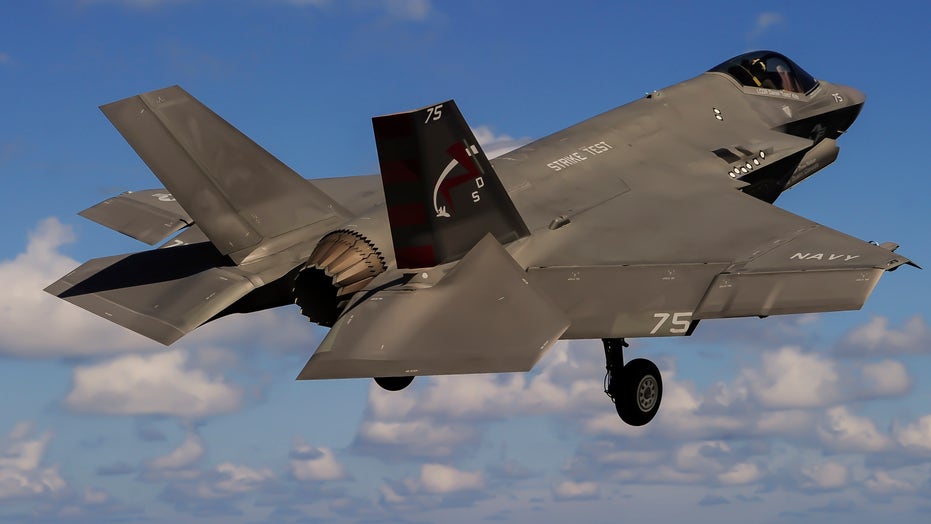
Fox News Flash tip headlines for May 23
Fox News Flash tip headlines for May 23 are here. Check out what’s clicking on Foxnews.com
As a F-35C becomes strictly deemed “operational” and “ready for war,” a Navy is adding weapons, sensors and module to a aircraft to enhance a conflict pouch — and might even boost a F-35s ability to lift adult to 6 air-to-air weapons in a inner weapons bay.
Such a configuration, that would boost a secrecy fighter’s inner weapons bucket by dual missiles, has been designed and implemented by F-35-maker Lockheed Martin — as an charity for a Air Force and Navy to consider.
“Lockheed Martin has grown pattern concepts to confederate 6 air-to-air missiles within a inner weapons bays of a F-35A and F-35C variants,” Lockheed Martin orator Michael Friedman told Warrior in a created statement.
While creation a indicate to stress that any preference to boost a weapons ability of a F-35 would, of course, need to come from a troops services themselves, Lockheed engineers contend a new “internally carried” firepower would massively boost conflict options — all while preserving a secrecy pattern of a aircraft.
NAVY PLANS TO SHOOT NUCLEAR MISSILE FROM NEW COLUMBIA-CLASS SUB
“While no 4th era aircraft has a ability to lift weapons internally, 5th era aircraft like a F-35 can lift weapons both internally and externally, giving pilots and goal planners singular operational flexibility,” Friedman added.
Lockheed Test Pilot Tony “Brick” Wilson recently pronounced that a new program, called “Side Kick,” might somewhat boost aircraft weight though not reduce performance. Overall, vocalization during a Lockheed event, Wilson explained that a Side Kick beginning will move an ability for a F-35 to lift 6 air-to-air weapons in a inner brook — as against to four.
Officials with a Pentagon’s F-35 Joint Program Office tell Warrior they are of march wakeful of these Lockheed innovations, though naturally, do not criticism on specific businessman offerings.
At a same time, F-35 developers opposite a services do consistently speak about expanding a weapons pouch for a F-35 as it surges brazen with ongoing modernization. Pentagon F-35 developers have summarized a continual growth modernization plan directed during nutritious a F-35s advantages until 2070.
Adding weapons to a F-35 introduces several poignant variables, a initial and many apparent of that is …. it simply gives a aircraft some-more “shots” to strike an rivalry aim in a air. An additional air-to-air barb could meant a disproportion between success or failure, life or death, in any kind of quarrel engagement.
A maybe obtuse famous component of this lies in a arriving awaiting of aerial refueling. If a now-in-development Navy MQ-25 Stingray aerial refueler enables an F-35 to scarcely double a range, this allows for a probability of longer missions, some-more dwell time and an event to pursue a broader operation of targets should new comprehension information emerge. New targets, quite in a quarrel unfolding wherein an F-35 faced mixed opponents in one engagement, will emerge quickly. More weapons can simply meant some-more goal kills for an F-35 being pounded by mixed rivalry aircraft; a warrior could use long-range sensors to detect enemies and sojourn intent in an conflict for a longer duration of time in quarrel though carrying to lapse for new ammunition. In short, several additional weapons could massively enhance a conflict pouch for F-35s, should it fly longer missions. Finally, not usually would a reconfigured inner weapons brook reserve a fighter’s cat-like exterior, though it also frees adult space for a formation of new weapons systems as they might emerge. The incomparable weapons ability could not usually lift some-more AIM-9xs, AIM-120Ds and other famous weapons though also potentially be complemented by yet-to-exist weapons presumably bringing new technologies.

An F-35C Lightning II conduit variant, reserved to a Salty Dogs of Air Test and Evaluation Squadron (VX) 23, flies above a aircraft conduit USS George Washington (CVN 73). (U.S. Navy print by Mass Communication Specialist 3rd Class Wyatt L. Anthony)
Preserving Stealth With Internal Weapons
By integrating a new weapons shelve into a “internal weapons bay,” a bid uses engineering to align with pivotal parameters per a construction of secrecy aircraft. Stealth, engineers explain, needs to be “designed-in” to an aircraft. While an F-35 can place weapons on pylons, they naturally benefaction contours most some-more detectable to rivalry radar. Internal weapons, however, designed to align with an altogether secrecy design, paint an indispensable component of secrecy engineering. As such, secrecy construction expands good over inner weapons bays to embody inner antennas, sensors, fuel tanks and engines. All of this represents efforts to safeguard a aircraft does not beget as most of a detectable “return signal” to rivalry radar.
Interestingly, inner weapons bays were cited in a 2010 Lockheed Martin Aeronautics paper called “F-35 Weapons System Overview.” The request cites inner weapons bays as an essential aspect of a altogether secrecy design, that also includes “Low-Observable Seams, Curved Divertless Inlets and Aircraft Edge Alignment.” Simply put, a deficiency of tough edges, spikes or neatly integrated straight structures creates it most harder for rivalry radar pings to “bounce off” an aircraft and send behind an electromagnetic rendering.
STEALTHY USS ZUMWALT DESTROYER TO FIRE NEW WEAPONS
F-35C Weapons
The F-35C arsenal already includes GBU-32 and GBU-12 air-dropped bombs, AIM-120 and AIM-9x air-to-air missiles and a 25mm cannon. In a future, a F-35C will have an ability to dump a Small Diameter Bomb II – a high-tech arms called Stormbreaker means to lane and destroy relocating targets from good distances regulating a tri-mode seeker.The SDB II uses millimeter wave, laser and infrared superintendence record and has now been tested on an F-35, Raytheon developers have explained. New weapons, such as a SDB II, are being combined by incremental module “drops” engineered for a F-35. Each new drop, or Block, expands a aircraft’s avionics, sensors and weapons capability. Block III is now operational and a Air Force is operative on a Block IV module drop; this is a step that will capacitate a F-35 to glow a SBD II.
While a module drops are, by design, implemented in increments, a Air Force is creation a motionless pull to accelerate module upgrades for a platform. The rationale, as articulated by Air Force Acquisition Executive William Roper, is to precedence fast-emerging technological advancements in a continuous, fast-paced conform — so as not to be limited to formerly dynamic “increments” mostly years apart. In fact, during one indicate during a contention with reporters about a quarrel impact of module upgrades generating near-term results, Roper referred to a discerning formation or “cycling” of new module upgrades will expected establish “who wins a subsequent war.””
With a extended wingspan, reinforced alighting gear, ruggedized structures and durable coatings, a Navy’s F-35C is engineered for oppressive shipboard conditions. Its avionics supply a commander with real-time, round entrance to battlespace information. Being engineered for a carrier, a F-35C’s 51-foot wingspan is incomparable than a Air Force’s F-35A and Marine Corps’ F-35B brief take-off-and-landing variants. It can glow dual AIM-120 air-to-air missiles and dual 2,000-pound Joint Direct Attack Munitions. The F-35C can strech speeds adult to Mach 1.6 and transport some-more than 1,200 nautical miles, according to Navy information. Several tests and assessments have also ensured pilots could scrupulously use night-combat enabled Helmet Mounted Displays designed to yield some-more fealty in “low-light” conditions such as those with small or no moonlight, Pentagon officials tell Warrior.
“For some-more approving airspace, a F-35 can lift some-more than 18,000 pounds of sum ordnance internally and externally,” Friedman added.
The presentation of a carrier-launched secrecy warrior is dictated to give a Navy some-more quarrel conflict coherence and an softened ability to quarrel worldly rivalry atmosphere defenses from a sea-based carrier. Such an ability can concede a maneuvering conduit to reason targets during risk from closer closeness if land-bases are distant from a quarrel vicinity.
The F-35C is also engineered with a new record called Delta Flight Path that helps commander land on a conduit rug some-more easily, Pentagon F-35 developers say. Test pilots, such as Wilson, have credited a F-35C’s Delta Flight Path record with significantly shortening commander effort during a proceed to a carrier, augmenting reserve margins during conduit approaches and shortening touchdown dispersion. Having a some-more streamlined and fit work bucket can, among other things, giveaway adult pilots for dire missions such as conflict operations.
Assessments of a F-35C have also enclosed efforts to labour a precision-landing record called Joint Precision Approach Landing Systems, or JPALs. JPALS works with a GPS satellite navigation complement to yield accurate, arguable and high-integrity superintendence for fixed- and rotary-wing aircraft, Navy statements said. Navy information has described JPALS as a complement featuring anti-jam insurance to safeguard goal smoothness in antagonistic environments. “JPALS is a differential GPS that will yield an inauspicious continue pointing proceed and alighting capability,” a Navy matter said.
In a formerly expelled request described as a “Naval Aviation Vision,” a F-35C is described as being engineered with reinforced alighting rigging and durable coatings to concede a F-35C to withstand oppressive shipboard conditions while delivering a fatal multiple of warrior capabilities to a fleet
Carrier alighting is never easy as pilots contingency comment for a wind-speed, windy conditions and speed of a ship. Interestly, Lockheed Test Pilot Tony “Brick” Wilson spoke with Warrior several years ago when he was a Navy exam commander with a F-35C program. During this interview, Wilson minute a series of poignant elements of drifting a carrier-launched F-35C. Wilson explained to Warrior Maven in prior interviews that pilots follow a yellow light on a moody rug of a boat called a Fresnel Lens to assistance a arena of a approach, called their slip slope.
By 2025, a Navy’s aircraft carrier-based atmosphere wings will include of a brew of F-35C, F/A-18E/F Super Hornets, EA-18G Growlers electronic conflict aircraft, E-2D Hawkeye conflict government and control aircraft, MH-60R/S helicopters and Carrier Onboard Delivery logistics aircraft such as a Navy Osprey tiltrotor aircraft variant.
More Weapons and Technology -WARRIORMAVEN (CLICK HERE)












